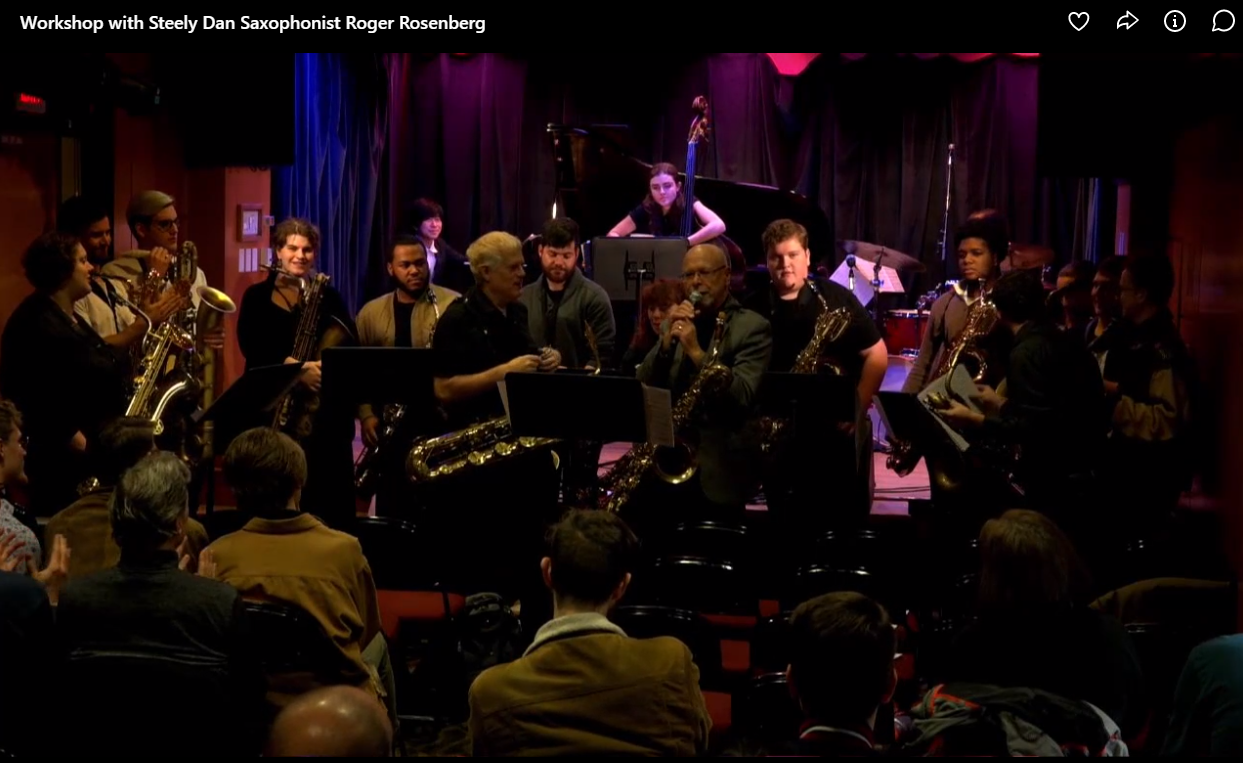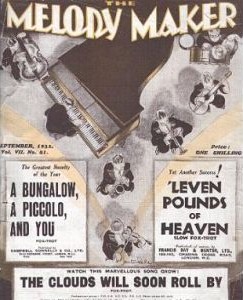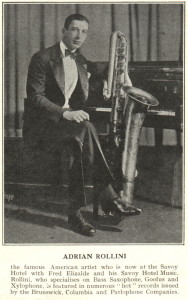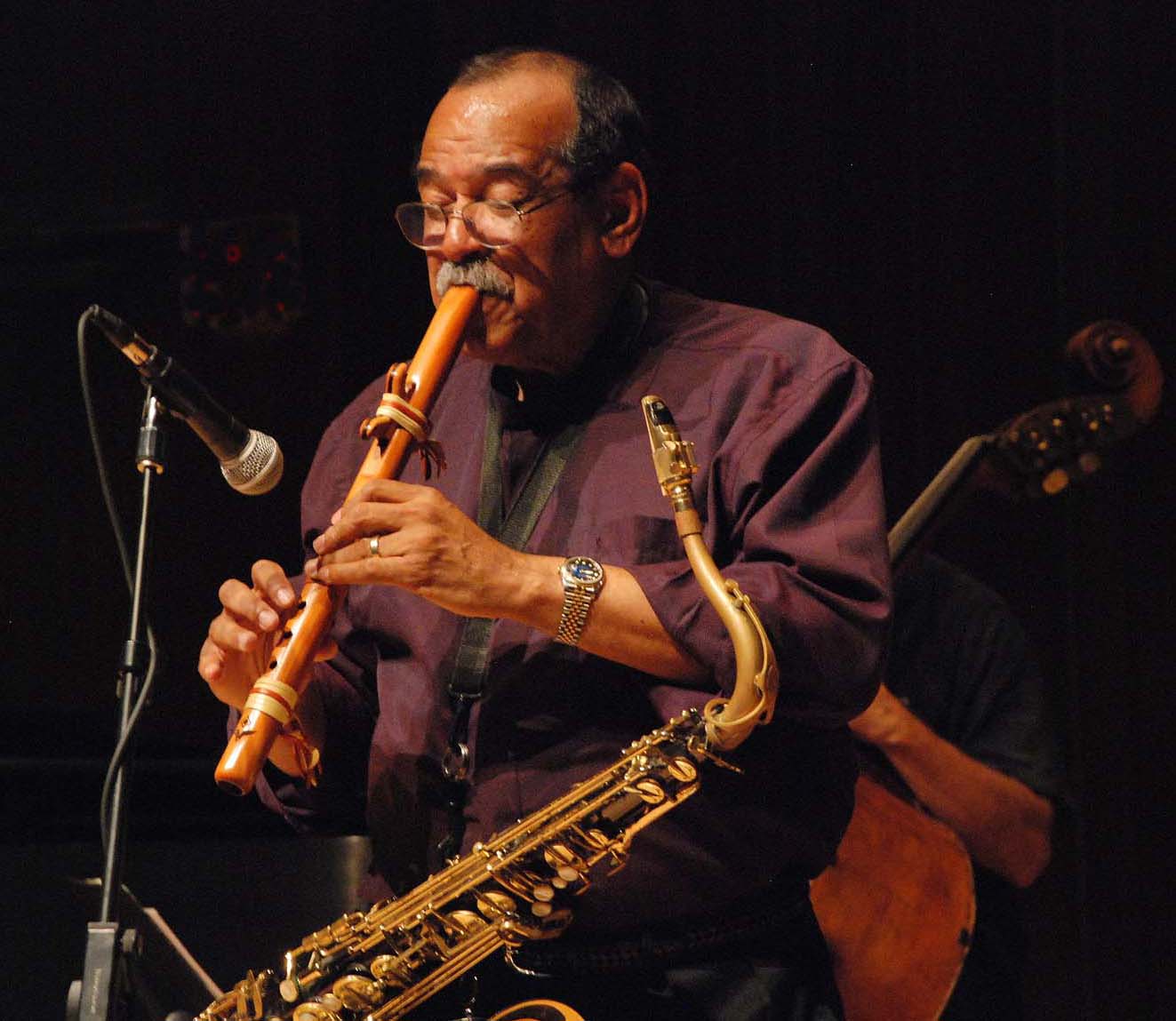What a great pleasure it is to share with you a fun hour and a half of baritone saxophone playing. Roger Rosenberg plays standards as well as some unique pieces then leads an all baritone ensemble. If 14 baritones on one stage sound frightening then you’re in for a surprise. The arrangements are the interesting and some of the student solos are very on point.
Category: Technique
Bass Saxophone articles in Melody Maker by Adrian Rollini
In 1929 Adrian Rollini sat down to pen what could be considered the earliest treatise on the bass saxophone for the Melody Maker Magazine. It was authored only a year after Rollini made the trip across the pond to play with the Savoy Ballroom band as lead by Fred Elizalde. This would be a short run for Rollini as he left the band in 1928 and returned to the US. Throughout his career Rollini defined and refined the roll for the bass saxophone in the hot jazz band. Of course he wasn’t the only person playing the bass saxophone but he was widely known from his time with Bix Biederbeck.
In the articles linked below Rollini touches on the major parts of bass saxophone ownership and paying. In fact much of what he describes still holds true today nearly 86 years later.
Ernie Watts Masterclass – JEN Conference 2012
I am a big fan Ernie Watts, from his crazy huge mouthpiece tip opening to his amazing melodic improvisations. This masterclass offers a great view into his personal sound concept, philosophy, practice techniques and improvisation pedagogy.
Here’s a warmup exercise based on the warmup Ernie recommends to start each practice session with.
The perfect mouthpiece
Lets take a moment to describe what I call the “perfect” mouthpiece. The perfect piece is one that allows you to play without thinking of your gear. You shouldn’t have to fight your mouthpiece. It should be transparent to the player and listener. If you have to fuss with the mouthpiece constantly then it’s not perfect for you. The mouthpiece should offer the performer the ability to express themselves as the hear themselves in their own tone concept. The perfect piece should offer the player the level of tonal flexibility that allows them to meet their musical expectations.
Clearly no one mouthpiece be be all things to all people but some have gone on to become standards. The Selmer S-80 piece has been the mainstay of classical and beginning sax playing for decades for it’s ability to blend, ease of use, clear focused tone. The Otto Link Tone Edge, has become a right of passage for players moving from classical to jazz. It’s large chamber and rollover baffle make it a preeminently flexible mouthpiece that easily covers jazz styles from the 20’s through the post bob era’s. The Dukoff and Guardala mouthpieces have become beacons of smooth jazz, rock, and contemporary jazz tone concept. Their high cliff baffles and small to medium chambers have been duplicated by mouthpiece makers all over the world. These pieces offer edge and punch to compete in an amplified world.
In just those few examples there are a variety of construction methods and potential applications. What those piece share in common is that the player has to choose for themselves what will work in their playing situation and preferences. A player who prefers their Dukoff in their fusion band might find a Otto Link too stuffy, whereas a player who couldn’t connect to their tone on a Jody Jazz or Guardala might find that a modified Selmer Soloist to be the key to unlock their creativity. It is truly the player which makes the mouthpiece.
What do you describe as the perfect mouthpiece? Let me know by leaving a comment.
So you want to play bass saxophone?
I’ll admit that I had no idea what I was walking into when I decoded I’d by a bass sax and learn to be proficient. Seriously, how hard could it be? The truth is that the bass is a saxophone but it’s also some very different. It is a resistance trainer, lung expander, wallet reducer, finger stretcher, backing breaking hulk of a horn and it’s quite fun to play.
Firstly I am referring specifically to my bass a 1923 Conn stencil keyed to High Eb. The old Conn and Buescher basses are the long wrap type. This means the upper portion of the horn doesn’t curl back on itself as much as baritone does making the main body tube considerably longer than the french wrap preferred by Selmer. French wrapped basses are more compact and more baritone like in their tone and timbre. Is any one type of bass better than another? Some say the long or American wrap has a bigger more booming voice whereas the French wrap blends into sections better and is easier to transport. I can’t speak the blend as I feel any horn can be made to blend but in terms of transportation I would have to agree.
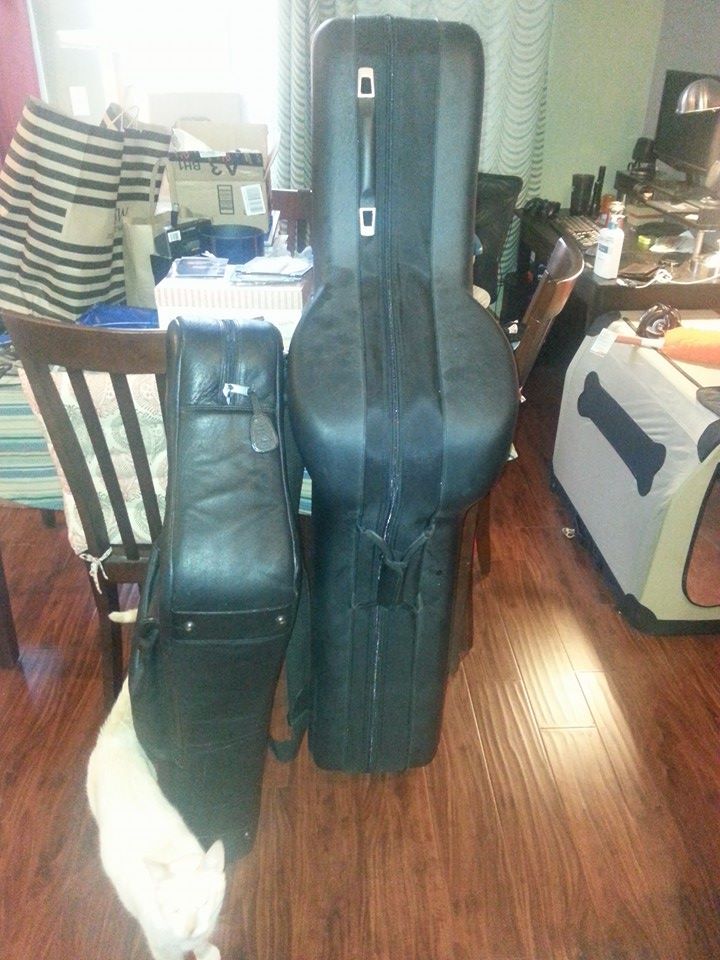 |
| Gard baritone gig bag (left) next to bass saxophone (right) rolling case |
From the start the first thing you and everyone will notice is that the horn is big. It’s not just big it’s heavy. Weight is around 20lbs without the case and nearly 40lbs with the case. My low-A Yamaha baritone clocks in at 14lbs so it’s a big leap in weight. This larger size and weight stresses everything related to the horn: cases, neck straps, thumb hooks, horn stands, and lastly your body. Let’s take a look at these elevents marked for bass destruction.
First up is the case. Considering the age of my horn [1923] it’s no wonder it is not in it’s not in it’s original case. That case likely fell apart long ago under the weight of the horn, the elements and poor maintenance. Thankfully my horn came to me nestled snugly in the wheeled case seen in this post.This is the same case that Steve Goodson used to sells on his site. It’s made by a company in China, I believe JinYin. It’s pretty expensive, $1200, for a case but it does do a great job at shrinking the bass to size to fit in my Min Cooper. Yes, I can fit a bass in my Cooper. I could easily fit the remainder of the sax family in as well as long as I stack them. With that in mind be prepared to buy a new case if you are still using the old coffin style or vintage shaped case.
Once out of the case and together you will need a method of holding the horn to you. I initially tried using the Neotech harnesses I use on baritone. those didn’t work as they didn’t have enough height adjustment to bring the mouthpiece to my mouth. On my bass the mouthpiece location ends up being about 6 inches lower than the baritone. The playing position places the mouthpiece at about half way down the horn verses at the top of the horn for baritone. This means any sax harness would need to have a great deal of vertical adjustment. Most harness don’t have this. have to return to using the tried and true neck strap. Neck straps have issues all their own separate to the pains in the neck they cause. A cheaper strap will usually have a nylon hook instead of a plastic coated metal hook. While this is great for protecting the finish it just isn’t strong enough to hold the bass. There is nothing worse than to have a horn go crashing to the ground because of a bad or broken nylon clasp.
In examining my horn I saw that sometime in the past 93 years the thumb hook had been repaired, perhaps more than once based on slightly different solder colors. I suspect that it took a hit to the thumb rest perhaps during a fall. The weight of this horn amplifies small hits. It’s the classic equation of force = mass * acceleration. A heavy sax dropping, sliding, or falling onto a surface is going to cause damage to something. That something is going to be the sax or the surface it hit.
As you might expect once you find a way to hang the horn from your person you will find that your body will develop some ache and pains. Good core support if vital if you want to play it suspended from your body. If you don’t then a good stand becomes the second most important purchase after your case. There are playing stands with wheels that allow you to position the horn for tooting while mounter firmly in the stand. There are also stands which are similar to baritone stands but have a much larger bell “U” to accommodate the larger bell of the bass. Saxrax has become the de facto bass stand for many players on the internet.
Lastly, being a bass sax player requires a change in mindset. Depending on the type of music you play you may not have the lead line. If you are the bass of the group then you have to play like the bass of the group. Low notes alone are only part of the bass equation. You have to become a rhythm instrument as well as a wind one. This requires rhythmic playing and where a drummer is involved a connection to them. The bass and drums feed and compliment each other. The bass provides the foundation of the chords while also complimenting the drum rhythms. This takes time and practice. There are several great bass sax players on Youtube who exemplify this rhythmic and chordal duality. Bert Brandsma of the Dixieland Crackerjacks is the first that comes to mind. The second is Joe Rushton who played with Red Nichols and the Five pennies.
Baritone Altissimo – Fingering Chart
It’s funny that my most view post was about playing altissimo on the baritone. I wouldn’t have guessed that it was so important so so many people. So much so that the post in question is rank #2 after a Youtube video when searching for “bari sax altissimo “. With that in mind I set out to find another finger chart that was specific to the baritone.
I recommend practicing these slowly with a tuner. Let me repeat this: WITH A TUNER. The tuner will show you just how far you are from the desired note without being amazed that you even hit them. It’s either in tune or it’s not. There is very little which stands out like out of tune altissimo.
I also recommend that before playing any of these notes you need to have a firm sense in your mind on what the note should sound like. Take a moment, to visualize your embouchure, fingerings, and finally hear the note before you take the breath. The act of pre-hearing and pre-playing the note in your mind will help to solidify and instill confidence in that note. You will be more likely to be in tune and more likely to hit the intended note when you want it.
This brings up the question of which fingering do I pick? I recommend picking a fingering based on 2 criteria: how well does it play in tune, how easily does this fingering transition in the next one.
Once you are able to hit these individual notes the next step is to take it from being a parlor trick to a valuable tool in your musical toolbox. How do we do this? With slow and deliberate scale practice. Place the metronome on 60bpm and play whole notes up and down the scale. Eventually as you master the new octave you move to halves, quarters, and finally eights.
.jpg) |
| http://www.ericdannewitz.com/ |
Baritone Altissimo – Advance Exercise
Once again Jeff Suzda brings the world of Baritone saxophone playing a great lesson on playing in the extended regions of the saxophone.His lesson is based on the major 9th arpeggios and is a great way to flex your chops and smooth out the transition between registers. Though he does not mention it I recommend doing this exercise with a metronome as well as with a tuner. Playing this pattern slowly and focusing on good tone, intonation and smooth note transition will bring the most benefit.
As usual, enjoy the video and please go and visit Jeff’s site at jeffsuzda.com.
Bebop Study #1
My first album was Miles Davis’s “4 and More” album. This album was a mind opener for me. It was fast, free, and fun while at the same time allowing me to use my fathers turntable with his permission. For a kid of 12 suddenly allowed to use the turntable this was a big deal. Listening to Miles, George Coleman on tenor sax, Herbie Hancock on piano, Ron Carter on bass and Anthony Williams on drums excited me to no end. I wanted to learn to play with the energy these players were bringing to the music.
Fast forward 2 decades and change and I am a more nuanced player but sadly I’d never gotten the bebop under my fingers. Years of playing ska, punk, and rock never asked that kind of musical commitment so it was placed on the back burner. Now armed with my copy of the Bebop Bible by Les Wise, yes I have a seemingly rare print copy, and musical accompaniment software I have begun transposing and starting down the path toward bebop understanding and hopefully some small measure of proficiency.
As recommended by Les Wise and several great local boppers I have the privilege of calling friends and musical colleagues, the second step to learning bebop is to build a vocabulary. This is done in 2 parts, the first is to listen and play along with the great players. The second is to practice bebop phrases in all twelve keys while carefully listening. This is what brought me to Les Wise’s book. It is full of great material to help you build a solid bebop vocabulary.
For this section I will be choosing one phrase, line, or lick from Les’s book and transposing it into all 12 keys. I recommend playing these over the chords using software like band in a box. This will help to place the phrases into musical context and should help you to assimilate them into your playing more quickly. If you don’t have Band-In-A-Box then the android app Chord-Bot is the next best thing and is easy to use. I keep ChordBot handy on every device I have. It’s seriously that good of a tool.
This weeks bebop vocabulary building exercise: Bebop Study Lick 1
Baritone Altissimo part II
Jeff Suzda has been a great help in sharing his altissimo techniques with the rest of us. His approach is generic to the saxophone and specific to the baritone. If you are unfamiliar with his altissmo then you haven’t heard his albums. His tone in the upper range is full and direct. It is the type of tone that reflects the years of study he has invested in it. Enjoy the video he posted on YouTube, it’s a great way to approach those difficult first altissimo notes.
Rethinking James Carter
My James Carter Experience
I’ll admit it, I’ve never been a huge fan of James Carter. I’ve always felt his tone was rather harsh and his playing style was somewhat unconvincing at times. By this I mean he played every other saxophone exactly as he plays his tenor. Soprano, Alto, Baritone, and Bass are all subject to the Carter experience. I don’t think there is anything wrong with having a unique tone and style. After all isn’t that what we all strive to have? But I feel he leaves a lot of the nuances of the particular horns behind when he applies his brand of playing to them. Carter seems to dominate any horn you put in his hands.
Don’t agree? There is something that you can hear and feel when you hear a musician who has worked out every corner in his sound on his chosen horn. That horn for Carter is clearly his tenor. He seem to know how to coax out every conceivable tone the horn can make both pretty and ugly. Yes, I said ugly. Have you heard him scream through the horn? It’s abrasive and rough on the ears. When he applies this coaxing to the other horns in the family that I feel like he’s leaving a lot of tonal possibilities on the table.
Now with that out of the way I have to say that I still believe the things I’ve said above but also that the man is a genius. The very things that I dislike about him are some of the things I have learned to like in him. He is a musician who is not afraid to reach beyond the current conventions and play anything in anyway.Why not play Satin Doll while slap tonguing every note on bass saxophone? How about a squeaking screaming, growling rendition of My Funny Valentine? His passion and volatility are worn on his shoulder as he plays and its infectious.
I would dare someone to present to me a living player who’s complete disregard for the modern playing conventions has changed the way tenor players and other saxophone players in general have seen their horns. Sure, many of his “advanced” have been used in rock and roll for ages but bringing them back to jazz is his legacy. Youtube is a wash with his performances and finding one to suit your needs is easy. Perhaps his online presence is his next greatest legacy.
In all I have come to appreciate his musicianship, technique, and playing outside of expectations. I am still unconvinced of his baritone and bass tone. Just not my cup of tea. Check out this Master Class.
Baritone Altissimo?
Extending the range of the baritone saxophone has been quite the adventure for many saxophone players. Like many I did not start on baritone, instead I began on alto then migrated to the baritone in college. Throughout the pre-bari time I spent countless hours working over the Top-Tones book by Siguard Rascher. I had extended my range to a confident 3 octaves on most scales and arpeggios. That was short lived when I moved to playing the baritone.
Why was it so difficult? The main difficulty was that it felt as though no harmonic was lining up the way they did on alto, fingered a Bb and out popped an A. My private teacher didn’t have a great explanation initially for this other than to pull the note down with my embouchure. It was a short time later that he explained that “Low-A” bari’s will play altissimo notes a half step lower due to the extended length of the horn when compared to a “low-Bb” horn. This made sense for me as my Buescher 400 bari felt more alto like in the altissimo range than my YBS-61. This put me on the quest to find charts which applied to the “Low-A” bari and facilitated smooth transitions between notes. After all if it is cumbersome or awkwards to finger then there is an increased risk that you’ll miss the note at the exact moment you need it.
 |
| Ronnie Cuber altissimo chart from The Saxophone Journal |
One of my favorite players, Ronnie Cuber, shared his fingerings for a few notes in a back issue of the Saxophone journal. Of course these fingerings are the ones he made up so that he could get around his horn. Which is a Mark VI for those who don’t know.
Cuber is not the only baritone player to extend his range successfully. The late Nick Brignola had a masterful tone in the upper registers. For a more modern player listen to the baritone player Jeff Suzda. His use of altissimo is both in good taste and beautiful on the ears. In recent weeks I’ve been in contact with him about his use of altissimo and he has forwarded me his fingering chart which is very fluid and comparable Cuber’s but more extensive. Suzda’s finger chart: Jeff Suzda’s Altissimo Chart for Baritone.
Of course the most important question to ask yourself before you head down the altissimo path is: why do it at all? The baritone is the lowest of the saxophone voices common in today’s music and is almost never called on to play in a range comparable to an alto. So why invest effort to learning to play into a register that is both difficult and, even when played well, still sounds somewhat odd. Imagine Avi Albrecht singing Alvin and the Chipmunk styled falsetto. For those not familiar with his powerful baritone voice consider Josh Turner or Randy Travis taking their voices in to the stratosphere.
For me the reason for the extended range is a personal challenge to be enjoyed by my wife and cats. I don’t play in to the range at a show unless written. For me, just knowing that I have that in my tool box is enough. Although there is a sadistic pleasure in playing the solo trumpet part of MacArthur park in altissimo while the solo trumpet is trying to figure out who’s messing with him. They never suspect the baritone player. By the way, I only did it twice for effect during rehearsals. Thankfully the other sax players never gave me away.

